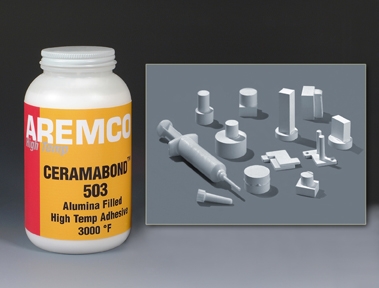Aluminum Oxide Bonding Using Ceramic Adhesive
November 1, 2022
Aluminum oxide (Al2O3), usually shortened to alumina, is a technical ceramic used in a wide range of high-temperature applications. It is valued as having one of the greatest cost-to-performance ratios of all engineering ceramics and subsequently finds wide use in various thermal and vacuum processes. The challenge when designing with alumina is creating components with […]
Aluminum oxide (Al2O3), usually shortened to alumina, is a technical ceramic used in a wide range of high-temperature applications. It is valued as having one of the greatest cost-to-performance ratios of all engineering ceramics and subsequently finds wide use in various thermal and vacuum processes. The challenge when designing with alumina is creating components with sufficient intricacy for given applications, or bonding multiple parts into complex assemblies using adhesives with the appropriate thermomechanical properties.
Introducing Alumina-Based Ceramic Adhesives
Technical ceramic adhesives are high-temperature bonding agents used to join dense ceramic components, and to ensure the resulting assembly is fit for purpose. Engineering-grade polycrystalline alumina can routinely withstand operating temperatures exceeding 1300°C, thus ceramic adhesives must perform under strict conditions.
The Aremco solution to bonding alumina is Ceramabond™ 503; an inorganic alumina-filled ceramic adhesive designed to resist peak temperatures as high as 1760°C. Not only is Ceramabond™ 503 ideal for extreme thermal processes, but its inherent inertness means it will not outgas in ultra-high vacuum (UHV) conditions. This makes it the ideal alumina bonding solution for the ceramic’s toughest applications.
Key Design Considerations for Ceramic Adhesives
Although bonding with ceramic adhesives is like using epoxies, extra consideration must be paid to the operating environment, the coefficient of thermal expansion (CTE), and the unique joint design.
Alumina ceramics are typically deployed in applications with high thermal loading, but the thermal performance of your ceramic adhesive is not the final word in joint performance. Ceramic adhesives, though offering exceptional chemical, electrical, and ultra-high thermal resistance, plus an inherent lack of out-gassing, exhibit slight porosity after curing. Ceramabond™ 503 is optimized for alumina-to-alumina bonding, and for joining other dense ceramics, but additional care may be needed to ensure the bond is gas-tight—which may prove critical in vacuum applications.
Additionally, joint design should account for the difference in the CTE between the adhesive and its substrates, to account for any mismatch that might reduce system reliability. Many ceramic adhesives fail due to their implicitly poor shear strength too. So, joints should be designed to not only account for differential CTEs, but to distribute mechanical stress uniformly.
Applications of Ceramabond™ 503
Our Ceramabond™ 503 ceramic adhesive is easily applied and can cure fully in under 2 hours at 371°C, with improvements in shear strength increasing with further curing. Its exceptional performance characteristics combined with its ease-of-application make it the ideal solution for various critical alumina bonding applications, including:
- Assembling dense ceramic components for UHV conditions
- Repairing ceramic sager plates
- Potting thermocouples and gas sensors
- Coating resistance wires
Looking for Ceramic Adhesives?
At Aremco, we formulate high-temperature ceramic adhesives using an array of fillers and binders, creating a selection of bonding agents for materials ranging from technical ceramics through to semiconductors. Browse our range of ceramic adhesives for more information.


 +1 (845) 268 0039
+1 (845) 268 0039
